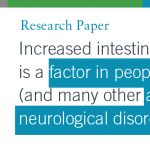A weekly round-up of current research summaries with my comments and interpretations:
In this paper (linked here), there is a discussion of the effect of exercising using whole body vibration. It is a review of multiple studies that investigated whole body vibration in patients with neurological disorders. The authors state that there is evidence for modest improvement in balance, strength, and spasticity in those with multiple sclerosis, Parkinson’s, cerebral palsy, and spinal cord injury. The benefit may be small, but for all these conditions, improvement was observed. Whole body vibration is another way to improve the effectiveness of your physical training. I discuss this technique in my exercise and e-stim course. Use the tools that you can access to get moving and get more out of your workouts!
This paper (linked here) talks about the biomarker IL10 as a predictor of disease progression and conversion of clinically isolated syndrome to multiple sclerosis. IL10 is closely related to your physical activity level. Move more to get a better IL10 by and lower your risk of disease progression. Consider signing up for my exercise and e-stim course. It’ll help you get moving in a way that’s appropriate to your ability and introduce you to tools to get more out of your workouts and lower your risk of disease progression (for MS and probably MOST systemic autoimmune conditions!).
It is so great to see another paper (linked here) talking about the link between our gut microbiome and the level of inflammation in the brain and speed of brain shrinkage. The evidence grows that the microbes in our gut speak directly to our immune cells and our brain cells. Even more exciting is the evidence that our microbes influence our ability to repair our myelin. And our clinical partners are recognizing that diet matters because diet influences the microbiome. I am so glad that I added a microbiome researcher to our team. We are studying how the Wahls Diet changes the microbiome. If you want to help fund the investigations we are doing, you can do so here.
It is wonderful to see that an investigation of a web-based self-management tool (linked here) is underway. More studies are investigating the use of health coaches, diet, and lifestyle interventions to manage MS symptoms. The study design that we used for our first study combined diet, stress management, exercise, and e-stim. It was sharply criticized because it was multimodal, but now others are doing multimodal lifestyle studies. Progress is happening!
Dark-colored foods, especially purple, blue, and black, are full of flavonoids and tremendously good for your brain. Multiple studies have shown deeply pigmented vegetables and berries are associated with reduced risk of cancer and all-cause mortality, and improved thinking and mental clarity. This paper (linked here) discussed the precise mechanisms in which these flavonoids positively impact our brains. Get your one-page summary of the diet we use in our clinics and our clinical trials here so you can start feeding your brain today (linked here).
Patients with MS have a higher risk of stroke (linked here). I theorize that this is due to the increased inflammation in the brain and body that is present in those with a systemic autoimmune condition. Therefore, I strongly urge everyone who has a systemic autoimmune condition to adopt an anti-inflammatory diet. At a minimum, remove sugar from your diet and eat more vegetables. Pick up the guide that we use in our clinics to get people started on a diet to reduce inflammation and risk of stroke here (linked here).
Pediatric cases of multiple sclerosis are on the rise. Treatment options are limited. If your child has multiple sclerosis or any neuroinflammation issues, I strongly urge you to use a therapeutic diet and lifestyle for the whole family as the bedrock of your disease management plan. The diet that we use removes sugar, gluten, casein, and eggs and ramps up vegetables. Get a one-page summary here.
Here’s a great review (linked here) of the benefits of eating deeply colored vegetables and berries. If you or a family member has an issue with mood or memory, consider adding more color to your diet. We have seen many patients experience remarkable changes in mood, memory, and quality of life as they implement the Wahls Diet. We have had people with Parkinson’s report less tremor, less stiffness, and more mental clarity. Patients with memory problems report their memory steadily improved. And those with chronic pain report steadily diminished pain. Pick up your one-page summary of the diet we use in clinic here (linked here).
This is an interesting study (linked here) on the use of telemedicine to encourage physical activity and manage fatigue. The interesting finding is those who participate in group teleconferences to encourage physical activity and self-management see a benefit. This certainly matches my observation. Putting people together in a support group helps people be more successful in adopting and sustaining more health-promoting behaviors.
Resveratrol favorably impacts our health by making changes to the SIRT pathways in our cells. This paper reviews (linked here) the role of SIRTS in multiple sclerosis. Eating a wide diversity of plants and avoiding sugar and processed foods increases the number of favorable shifts that occur in how your cells conduct the chemistry of life. Many of the compounds that impact SIRT are in deeply pigmented vegetables and berries, concentrated in the skin. You can get a copy of the diet we use in our clinic here.
Trigeminal Neuralgia is a condition where electrical jolts of facial pain come on randomly. It is a common problem in MS patients (linked here), is often difficult to manage, and has severe negative impact on the quality of life. I have it as part of my multiple sclerosis and suffered greatly from it for decades, but thankfully I am now pain-free. If you struggle with trigeminal neuralgia, I urge you to consider adopting the Wahls Protocol, a diet and lifestyle program that has helped many people reduce pain and improve quality of life. I have had great success, and it could help you too. Pick up the Wahls Protocol to learn more about what you can do – it is more than just a dietary plan. It can help you and everyone in your family experience less pain and feel more energetic.




